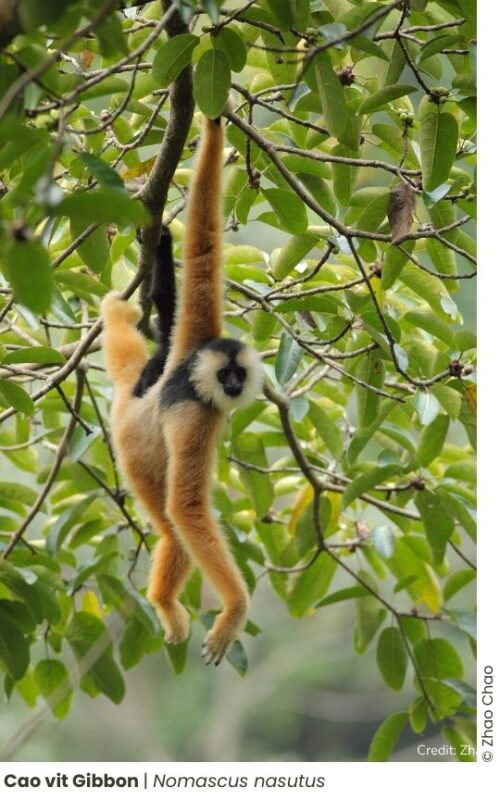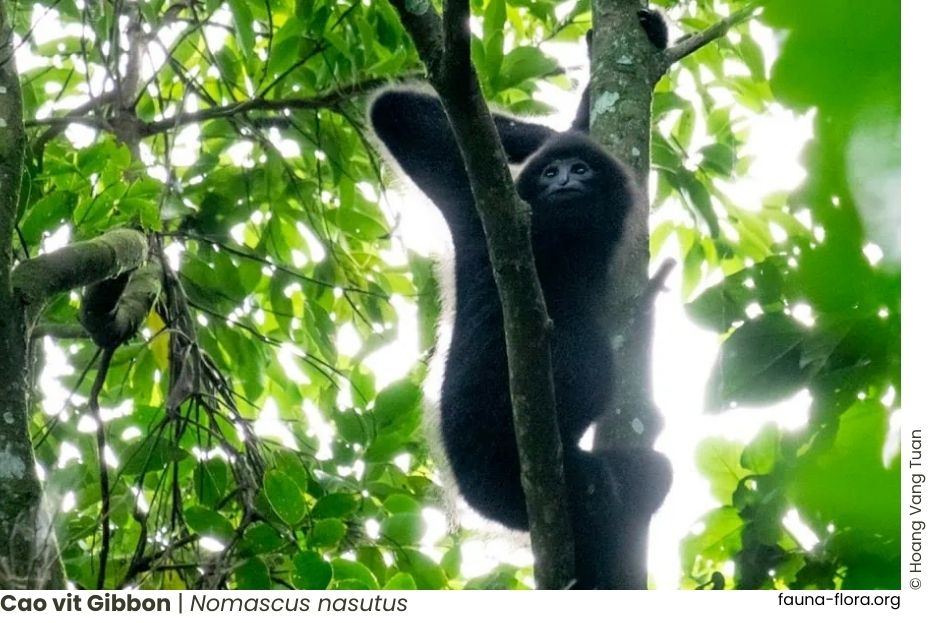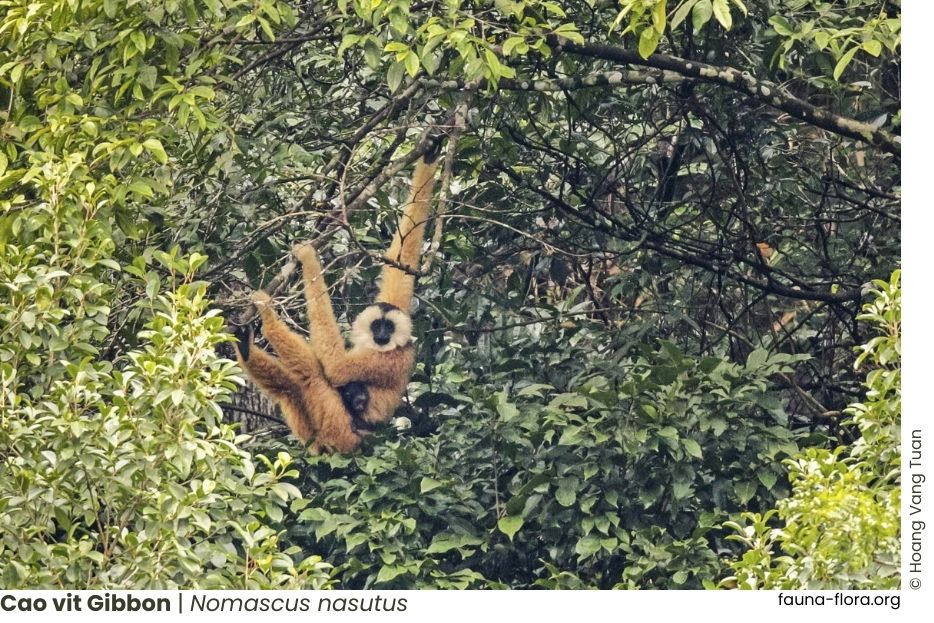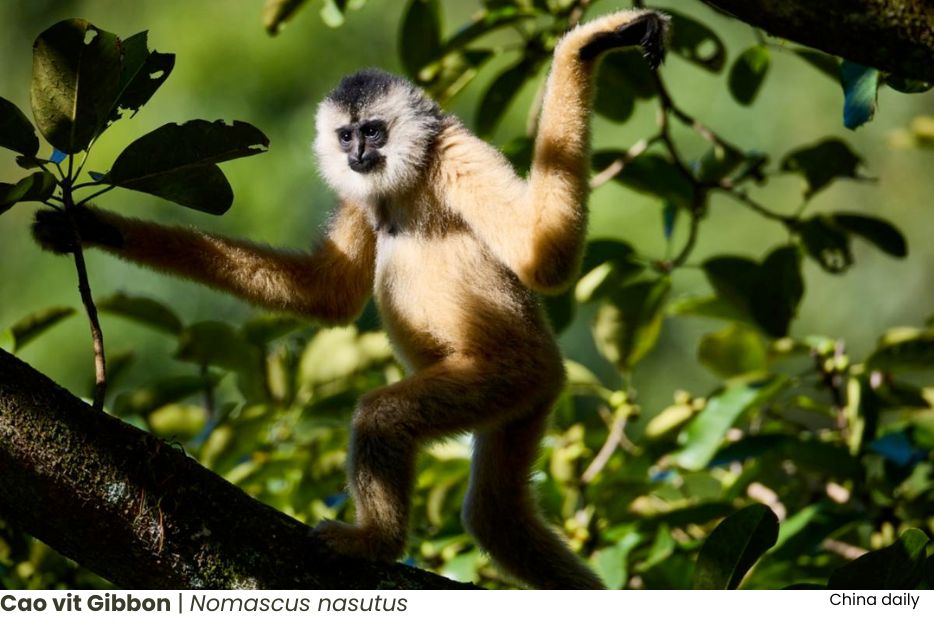Nestled within the dense, emerald-green forests of Vietnam, the Eastern Black Crested Gibbon (Nomascus nasutus), also known as the Cao-vit black crested gibbon or the Cao-vit crested gibbon, emerges as a symbol of the country’s unique and fragile biodiversity. The term “Cao-vit” originated from the sounds of their calls or songs that villagers of Ngoc Khe, Phong Nam and Ngoc Con communes of Trung Khanh District, Cao Bang Province of Vietnam use to name them. This name was officially used by gibbon experts since the rediscovery.

Taxonomy and Classification – Eastern Black Crested Gibbon:
Regnum: Animalia
Phylum: Chordata
Class: Mammalia
Ordo: Primates
Familiar: Hylobatidae
Genus: Nomascus
Species: Nomascus nasutus

Belonging to the Nomascus genus, the Eastern Black Crested Gibbon is distinguished by its sleek black fur, a striking crest of hair crowning its head, and long, slender limbs. Males and females exhibit subtle differences in coloration, with the males often boasting a more prominent crest. Their agile and acrobatic movements through the forest canopy reflect not only their physical prowess but also their adaptation to the intricate ecosystems they inhabit.
Habitat and Distribution:
Thriving amidst the towering trees of Vietnam’s evergreen forests, these gibbons find sanctuary in the Annamite Range. This mountainous terrain, stretching through both Vietnam and Laos, provides the ideal habitat with dense canopies, offering protection and sustenance. Unfortunately, the Eastern Black Crested Gibbon’s distribution is increasingly confined to fragmented patches of primary and secondary forests, raising concerns about its long-term survival.

Behavior and Social Structure:
Beyond their distinctive appearance, the Eastern Black Crested Gibbons are known for their captivating melodious calls that echo through the treetops. Living in small family groups, they form strong monogamous bonds. Their social structure is characterized by cooperation and intricate communication through vocalizations, ensuring the cohesion of the family unit. Acrobatic displays in the treetops showcase not only their agility but also the sophistication of their social interactions.

Reproductive Biology:
Reproductive strategies are vital for the survival of any species, and the Eastern Black Crested Gibbon is no exception. Monogamous pairs engage in elaborate courtship rituals, strengthening their bonds through grooming and mutual displays. The gestation period for females is around seven months, and the birth of a single offspring is a significant event within the social group. Infant gibbons are nurtured and protected by both parents, emphasizing the cooperative nature of their familial bonds.

Conservation Status:

Despite their resilience, Eastern Black Crested Gibbons face a critical threat to their existence. Classified as Critically Endangered by the International Union for Conservation of Nature (IUCN), their population has drastically declined due to habitat loss, hunting, and the illegal pet trade.
What little remains of the species’ habitat is under pressure from fuel wood collection, cultivation in valley bottoms, and livestock grazing, especially of goats, by local Vietnamese and Chinese ethnic minorities. Hunting of this transboundary gibbon population has been controlled with the gazettement of protected areas in both Vietnam and China and subsequent enforcement, although hunting of other taxa does still occur.
It should be noted that even occasional hunting events of gibbons would be very detrimental to the species’ long-term viability, and continued vigilance is required. Problems intrinsic to small, single populations may pose a significant long-term risk to population viability through inbreeding, disease outbreaks, extreme weather events and fires and climate change. A recent Population and Habitat Viability Analysis exercise suggested that the last remaining population of these gibbons may be reaching carrying capacity, making habitat restoration a significant priority.
Why don’t you visit Vietnam on a primate discovery tour? Click here
Wildlife Tours into the Vietnam Primate Kingdom
In the heart of Vietnam’s Annamite Mountains, the Eastern Black Crested Gibbon’s tale unfolds—a story of resilience, intricate social structures, and the challenges of coexisting with an ever-changing environment. As we navigate the complexities of their taxonomy, behavior, and conservation status, let us heed the call to protect and preserve, ensuring that the haunting calls of the Eastern Black Crested Gibbon continue to resonate through the canopies of Vietnam’s precious forests for generations to come.
Across Vietnam, conservation efforts are expanding—from reforestation projects to wildlife rescue and habitat protection. At WANEE, we believe that the more we appreciate nature, the more we’ll want to protect it. That’s why our tours are designed to inspire a deeper love for wildlife and a stronger commitment to conservation.
While trying harder every day to protect the balance of nature, our wildlife tours give tourists the chance to explore Vietnam’s natural beauty, understand how different habitats connect, and take action to protect them.
Scheduled Wildlife Tours
Tailored Wildlife Tours
Click here to see more tailored tour options
Visit our sites:
– Facebook: WANEE Vietnam (Wild and Nature Exploring)
– Instagram: WANEE Vietnam and WANEE Kids hub
Are you looking for Wildlife Tours in Vietnam?
WANEE VIETNAM is your go-to destination for "Wildlife Tours in Vietnam", specializing in Birding, Primate Watching, Herping, Photography Tours and Educational Tours led by our expert guides.Hot-spot for Birding in Vietnam
all birding in hot-spot informative info [updated Jan 2023]
Nr. Nature reserve; Np. National Park; mt. Mountain
How to Identify the Greater Sand Plover, Tibetan Sand Plover and Siberian Sand Plover
Identification Differences within the Sand Plover Complex: The sand plover group, which was traditionally divided [...]
Highlights of Cat Tien National Park Reptiles and Amphibian Endemics
Spanning over 71,350 hectares of tropical forests, grasslands, and wetlands, Cat Tien National Park is [...]
Highlights of Cat Tien National Park Mammals in a World Biosphere Reserve
In addition to reptiles and birds, Cat Tien National Park is also rich in mammals, [...]
Kontum Plateau Endemic and Highlight bird
Kontum Plateau Endemic And Highlight Bird species like Chestnut-eared Laughingthrush and top birding routes while [...]
Dalat Plateau Endemic and highlight bird
The Dalat Plateau is a birdwatcher’s paradise, renowned for its exceptional biodiversity and unique highland [...]
Cat Tien National Park Endemic and Highlighted Birds
Covering 71,920 hectares in southern Vietnam, Cat Tien National Park is home to a number [...]